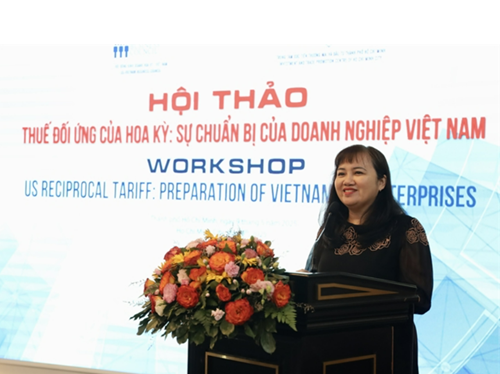The workshop, titled “U.S. Reciprocal Tariff: Preparation of Vietnamese Enterprises,” was hosted by the Investment and Trade Promotion Center of Ho Chi Minh City (ITPC) in collaboration with the U.S.-Vietnam Business Council, drawing strong participation from the local business community.
In her opening remarks, ITPC Deputy Director Cao Thi Phi Van reaffirmed the U.S. position as Vietnam’s largest export market.
    |
 |
|
Cao Thi Phi Van, Deputy Director of the Investment and Trade Promotion Center, speaks at the “U.S. Reciprocal Tariff: Preparation of Vietnamese Enterprises” workshop in HCM City on May 9. |
“Over the past five years, Vietnam has consistently maintained a substantial trade surplus with the U.S., rising from approximately 63.4 billion USD in 2020 to nearly 106 billion USD in 2024. Currently, Vietnam - like many other nations - is subject to the U.S.’s reciprocal tariff measures.”
In response to this challenge, the Vietnamese government is intensifying negotiations with the U.S. to foster a balanced and sustainable bilateral trade relationship.
Domestically, efforts are being intensified to monitor product origin, boost the domestic market, and facilitate bilateral investment projects.
Van also encouraged businesses to view these challenges as catalysts for growth and innovation.
She emphasized that the municipal administration and the business community are advancing strategic initiatives to diversify markets, products, and supply chains, enhance product quality and competitiveness, and remain agile in the face of global economic shifts.
In particular, leveraging the benefits of the 17 effective free trade agreements will serve as a critical foundation for expanding development space and strengthening international integration.
At the seminar, Dr. Tran Son, Assistant Professor of Business at SUNY Cobleskill, New York, and business development advisor at the U.S.-Vietnam Business Council, highlighted the shift in U.S. trade policy from “free trade” to “strategic trade” to focus on industrial policy and national security. This shift, he noted, presents both opportunities and challenges for trading partners.
Vietnam is viewed as a China+1 destination and the U.S. is watching closely for anti-dumping, labor standards, mislabeling and rule-of-origin violations, Son said.
The U.S. tariffs are here to stay, requiring Vietnam to adopt a proactive and strategic approach. Agility, trust, and innovation are key factors for success in this environment, he affirmed.
He outlined three key strategic options for Vietnamese firms: ensuring full compliance with regulations by strengthening supply chain documentation, maintaining transparent origin labeling, and early adoption of U.S. and E.U. standards; moving up the value chain by shifting from Original Equipment Manufacturer (OEM) to Original Brand Manufacturer (OBM), investment in branding, innovation, and customer development; and actively working with trade associations and policymakers to position Vietnam as a reliable trade partner.
He also called for a long-term national and industry-level branding strategy to reposition Vietnam as a producer of high-value and distinctive products, particularly in handicrafts, agriculture, and seafood.
From a practical logistics perspective, Mohammed Selia, CEO of US-based FulfillPlus, provided an in-depth analysis of U.S. import regulations across industry categories.
A fundamental principle exporters must understand, he said, is that U.S. import duties are paid upon clearance at the port of entry, determined by the HTS code, declared value, and country of origin. Each industry requires thorough research and preparation.
Apparel and textiles are subject to tariffs ranging from 10% to 30% and must comply with strict labeling requirements from the Federal Trade Commission (FTC) and accurate product classification to avoid unnecessary delays.
The furniture industry, particularly wood products, must be wary of anti-dumping duties and comply with the Lacey Act, which prohibits trade in illegally sourced plant materials. Certain U.S. states, such as California, have additional requirements for flame-retardant materials.
For agricultural and seafood products, FDA/USDA registration and advance import notice are mandatory. In many cases, maintaining the cold chain is also required.
In contrast, handicraft and artisan products often enjoy low or zero import duties, though it is essential to avoid materials derived from prohibited animal species.
To achieve long-term success in the U.S. market, Selia emphasized the importance of maintaining local inventory to support faster delivery and improve customer satisfaction.
He also stressed the need for continuous investment in product quality, branding, attractive packaging, and partnering with reputable U.S. logistics providers as a key strategic advantage.
Source: VNA